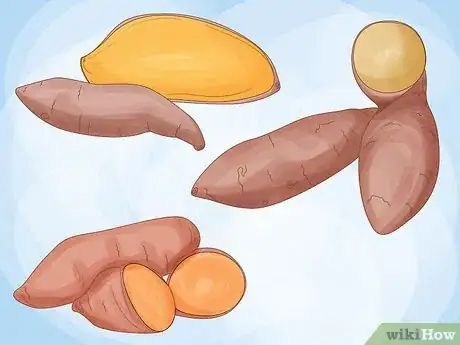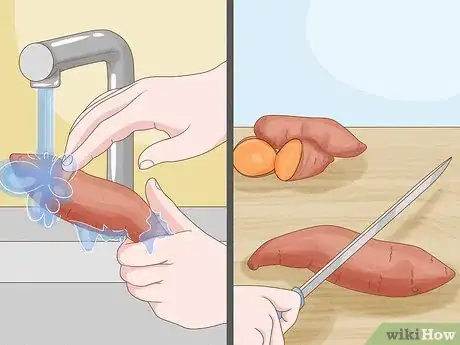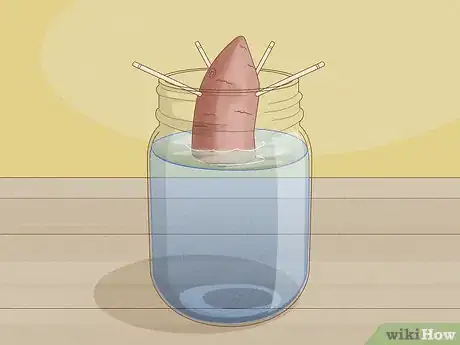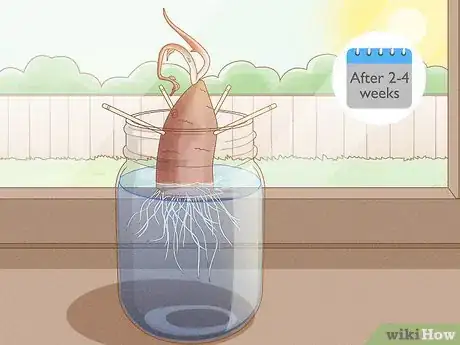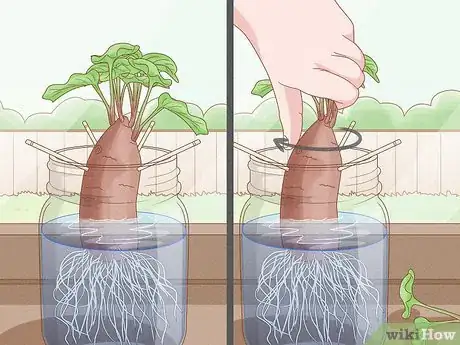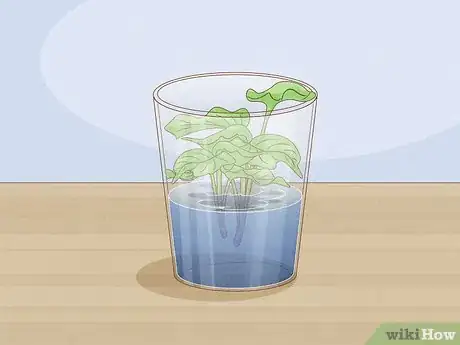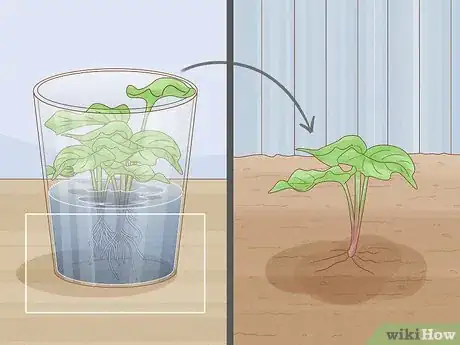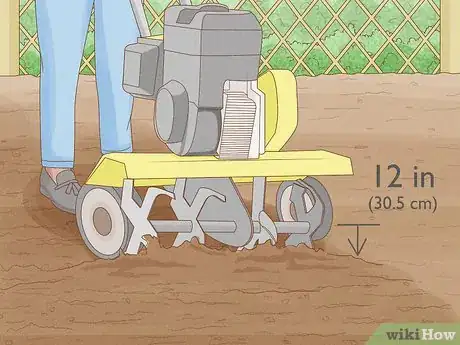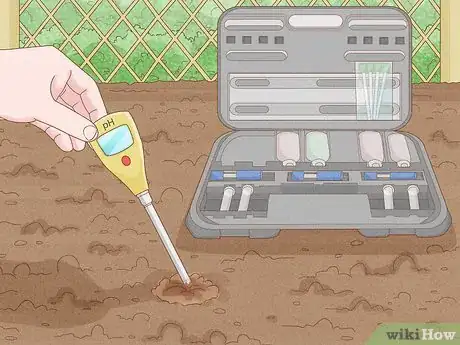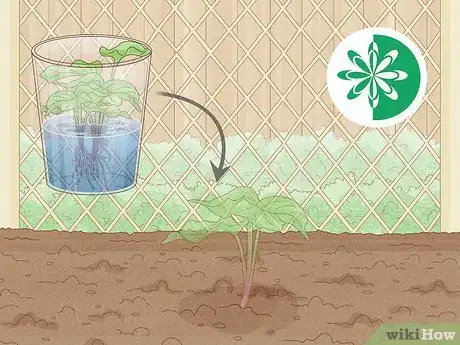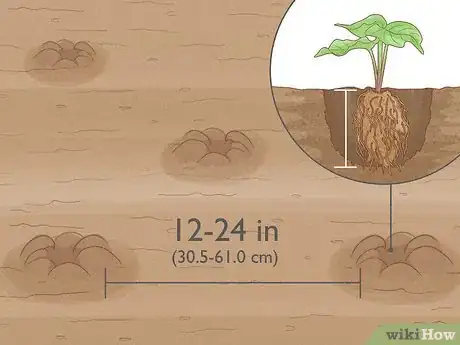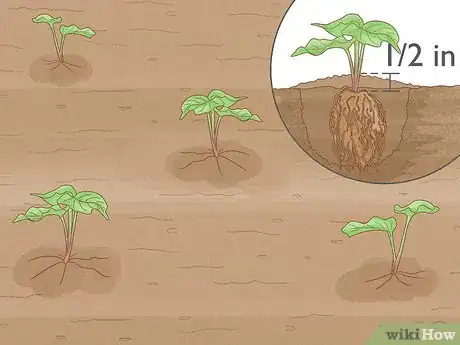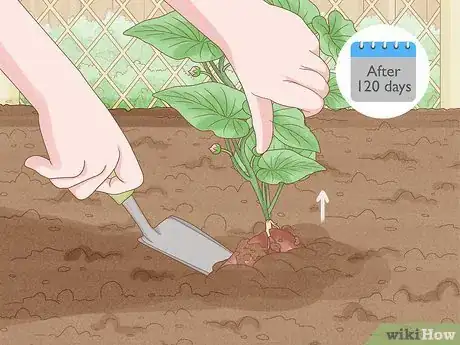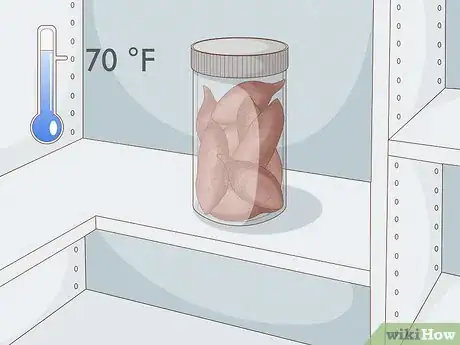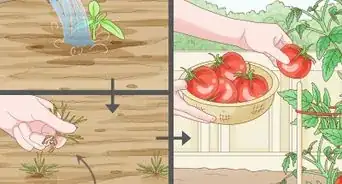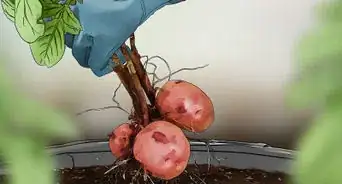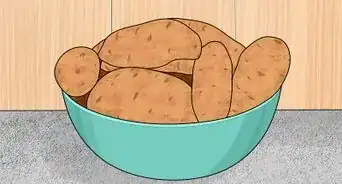This article was co-authored by Andrew Carberry, MPH. Andrew Carberry is a Food Systems Expert and the Senior Program Associate at the Wallace Centere at Winrock International in Little Rock, Arkansas. He has worked in food systems since 2008 and has experience working on farm-to-school projects, food safety programs, and working with local and state coalitions in Arkansas. He is a graduate of the College of William and Mary and holds a Masters degree in public health and nutrition from the University of Tennessee.
wikiHow marks an article as reader-approved once it receives enough positive feedback. This article received 19 testimonials and 92% of readers who voted found it helpful, earning it our reader-approved status.
This article has been viewed 288,987 times.
If you're looking to start a garden, sweet potatoes are a relatively low-maintenance plant that offer a bountiful harvest later in season than most other fruits and veggies. If you have a sunny area in a warm climate, you can plant these lovely copper-colored tubers and have fresh sweet potatoes from your own garden on the table for Thanksgiving dinner. Take these steps to grow your sweet potatoes from the ground up, starting with making your own slips.
Steps
Starting Your Slips
-
1Choose a sweet potato. Slips are small sprouts that are grown from pre-existing sweet potato plants. You can choose to order these online or from a garden center, but you can also grow them at home easily. Find a mature, healthy sweet potato plant from the store or a friend’s garden.[1]
- The most common and popular sweet potato varieties (available at most stores) are Beauregard, ‘bunch’ Porto Ricos, and centennials.
-
2Make sure you have the right climate. Sweet potatoes are a tropical plant. This means that they grow well in USDA hardiness zones 9, 10, and 11. This area includes most of the southern and south-western United States. If starting your own slips, start sprouting them in March or April. Slips should be planted in the ground in May or June.Advertisement
-
3Prepare your potato. When you’ve gotten your hands on 1-2 healthy sweet potatoes, stick them in the sink and wash them well. Then, cut your potato in half. If the potato is particularly large, consider cutting it into thirds or fourths.
-
4Fill a jar with water. The way your slip-growing works, is that you’ll place your potato half in/half out of a container of water. Use a jar or a glass cup with an opening large enough to fit your potato, and fill the whole thing with water.
-
5Place your potato in the water. Stick 4-5 toothpicks out of the sides of your potato equidistant apart and near the middle, like spokes on a wheel. Place the potato into the jar/glass of water with the cut side down, with the toothpicks holding half of the potato out by balancing it on the rim of the glass.
- Do this for every slice of potato that you have, with each section in a different jar.
-
6Add some light and heat. Move the jar with the potato onto a windowsill that gets a lot of sunlight.
-
7Let your slips grow. Wait for 2-4 weeks for the small leafy slips to begin sprouting out of the top of the potato.
-
8Harvest the slips. When the top of your potato is covered in slips, carefully twist each one off individually. They won’t have roots yet and will resemble small leaves with a short stem.
-
9Put your slips in water. Fill a shallow bowl with a bit of water, around 1” or less depending on the number of slips you have. Set the slips in the bowl so that the stem is submerged in the water. Leave them like this for several days, until roots have formed from the bottom.
- Add fresh water once a day or so to keep the slips healthy.
- If any of the slips are not forming roots or begin to wilt, throw them out.
-
10Get your slips out for planting. After 2-3 days, your slips should have developed roots at the bottom. At this point, dump out the water in the bowl and bring your slips out for planting. These are best placed directly into your garden rather than in individual planters to keep the roots intact.[2]
Preparing Your Garden
-
1Choose a garden plot. Sweet potatoes grow primarily underground, but their vines grow above the ground. Each vine can grow to be over ten feet long. Make sure your garden plot has plenty of room for the vines. Sweet potatoes prefer a warm environment, so try to choose an area that gets a lot of sunlight (especially if you live in the north) and is well drained.
-
2Till the earth. Being tubers, sweet potatoes will grow deep in the earth. Make sure they’ll have an easy time of it by tilling the soil about 12 inches (30.5 cm) deep. Get the soil as loose and light as possible, incorporating gardening soil if necessary.
-
3Prepare the soil. As will all fruit and vegetable planting, having nutrient rich soil is necessary for a bountiful harvest. Add a layer of good planting soil or compost. Remove any large rocks that might be present. Check the pH of your soil. If the pH is not neutral, adjust the pH with peat moss or wood ash to compensate for acidity or alkalinity until it is neutral. This is called amending the soil.
- You can buy pH testing kits for your garden at a garden center or store.
-
4Know when to plant. Because of their heat-loving tendencies, sweet potatoes need to have warm soil in order to flourish. Wait till at least a month after the most recent frost, in the beginning of spring, to plant your slips.
-
5Choose a mulch. Help your sweet potatoes to grow by adding mulch over the top to trap heat. If you are in a particularly cold area, get some black plastic mulch or a similar heat-trapper to place over the potato plants after planting.[3]
Planting Your Sweet Potatoes
-
1Dig your holes. Sweet potato slips need a bit more space than some other garden vegetables, so dig your holes 12–24 inches (30.5–61.0 cm) apart each. They need be only as deep as the root ball on the bottom of the slips and about ½ an inch up the base of the plant.[4]
-
2Plant your potatoes. Place each small slip in your pre-dug holes and cover the stems with soil about ½ of an inch up the base. The leafy part of the potato plant will begin to sprawl in vines outwards while the roots will produce the tubers between 6–12 inches (15.2–30.5 cm) deep in the soil.
-
3Add your mulch. Protect your sweet potatoes from cold weather by adding your chosen mulch to the top. This will also help to block out weeds and prevent too much vine growth, which steal energy from tuber growth.
-
4Water the plants. At first planting the sweet potatoes will require a lot of water. Over time, you should reduce the amount that you water them until they receive moisture only about once a week. Begin watering daily, knocking off days from your watering schedule as each week progresses.
-
5Wait for the tubers to develop. Sweet potatoes have a relatively long fruiting period, becoming ripe and ready to harvest in the early fall (hence their association with Thanksgiving). Continue watering on a weekly basis, and weeding the beds if necessary to keep the plants healthy.
-
6Harvest the sweet potatoes. After about 120 days after planting, the sweet potatoes should have reached full maturity. When possible, wait until the last possible time (the last warm weather before a frost) to harvest the sweet potatoes, as this will result in larger and more tasteful tubers.
-
7Cure the sweet potatoes. One of the most important steps, sweet potatoes must be cured after harvest. This will help them to develop their flavor (they won’t have much immediately after being dug up) and to grow a tougher skin - literally. Place the sweet potatoes in an area with a temperature of 85–95 °F (29–35 °C) with 80-90% humidity for 5-10 days. After this, they should be ready to eat![5]
- Consider using a small space heater and a humidifier in a large closet or small room to cure the potatoes.
-
8Store your sweet potatoes. One of the best things about these lovely tubers is that they will remain fresh and good to eat for many months if stored properly. Keep the potatoes in temperatures hovering around 70 degrees (that means no refrigeration!) in an open, dry area. Never store your sweet potatoes in a plastic bag or tightly sealed container.[6]
Expert Q&A
Did you know you can get expert answers for this article?
Unlock expert answers by supporting wikiHow
-
QuestionMy sweet potatoes started to sprout in our bowl when we came back from a trip. Can I still plant them, and if so, how?
 Andrew Carberry, MPHAndrew Carberry is a Food Systems Expert and the Senior Program Associate at the Wallace Centere at Winrock International in Little Rock, Arkansas. He has worked in food systems since 2008 and has experience working on farm-to-school projects, food safety programs, and working with local and state coalitions in Arkansas. He is a graduate of the College of William and Mary and holds a Masters degree in public health and nutrition from the University of Tennessee.
Andrew Carberry, MPHAndrew Carberry is a Food Systems Expert and the Senior Program Associate at the Wallace Centere at Winrock International in Little Rock, Arkansas. He has worked in food systems since 2008 and has experience working on farm-to-school projects, food safety programs, and working with local and state coalitions in Arkansas. He is a graduate of the College of William and Mary and holds a Masters degree in public health and nutrition from the University of Tennessee.
Food Systems Expert
-
QuestionHow far apart should sweet potato rows be?
 Andrew Carberry, MPHAndrew Carberry is a Food Systems Expert and the Senior Program Associate at the Wallace Centere at Winrock International in Little Rock, Arkansas. He has worked in food systems since 2008 and has experience working on farm-to-school projects, food safety programs, and working with local and state coalitions in Arkansas. He is a graduate of the College of William and Mary and holds a Masters degree in public health and nutrition from the University of Tennessee.
Andrew Carberry, MPHAndrew Carberry is a Food Systems Expert and the Senior Program Associate at the Wallace Centere at Winrock International in Little Rock, Arkansas. He has worked in food systems since 2008 and has experience working on farm-to-school projects, food safety programs, and working with local and state coalitions in Arkansas. He is a graduate of the College of William and Mary and holds a Masters degree in public health and nutrition from the University of Tennessee.
Food Systems Expert
-
QuestionCan sweet potato be planted in cuttings?
 Community AnswerYes. Sprout a sweet potato in a glass of water using toothpicks to suspend it halfway in the glass. Once it has sprouted, cut it in half lengthways and bury the sprout half in the ground slightly, water regularly, and with some patience you too can have nice sweet potatoes.
Community AnswerYes. Sprout a sweet potato in a glass of water using toothpicks to suspend it halfway in the glass. Once it has sprouted, cut it in half lengthways and bury the sprout half in the ground slightly, water regularly, and with some patience you too can have nice sweet potatoes.
Warnings
- Avoid fertilizing sweet potatoes during the growing season. Fertilizing will encourage heavy vine growth and light tuber growth. Miracle Grow or similar fertilizers, esp. high nitrogen fertilizers, will make many leaves, but fewer, smaller potatoes.⧼thumbs_response⧽
References
- ↑ http://www.diynetwork.com/how-to/outdoors/gardening/how-to-plant-and-grow-sweet-potatoes
- ↑ http://www.diynetwork.com/how-to/how-to-plant-and-grow-sweet-potatoes/index.html
- ↑ http://www.gardeners.com/How-to-Grow-Sweet-Potatoes/7474,default,pg.html
- ↑ http://www.almanac.com/plant/sweet-potato
- ↑ http://www.motherearthnews.com/organic-gardening/growing-sweet-potatoes-zm0z11zsto.aspx?PageId=2#axzz2fk96sLhx
- ↑ http://bonnieplants.com/growing/growing-sweet-potatoes/
About This Article
If you want to grow your own sweet potatoes, choose a sunny spot with well-drained soil. The best time to plant sweet potatoes is about a month after the last frost of the season. Till the soil about 12 inches deep, then plant your sweet potato slips 12-24 inches apart and just deep enough to cover the root ball. Mulch the area around the plants and water them thoroughly, but gradually decrease how much water they get. Harvest the sweet potatoes about 120 days after you planted them. For more tips from our Gardening co-author, including how to start your sweet potato slips, read on!
